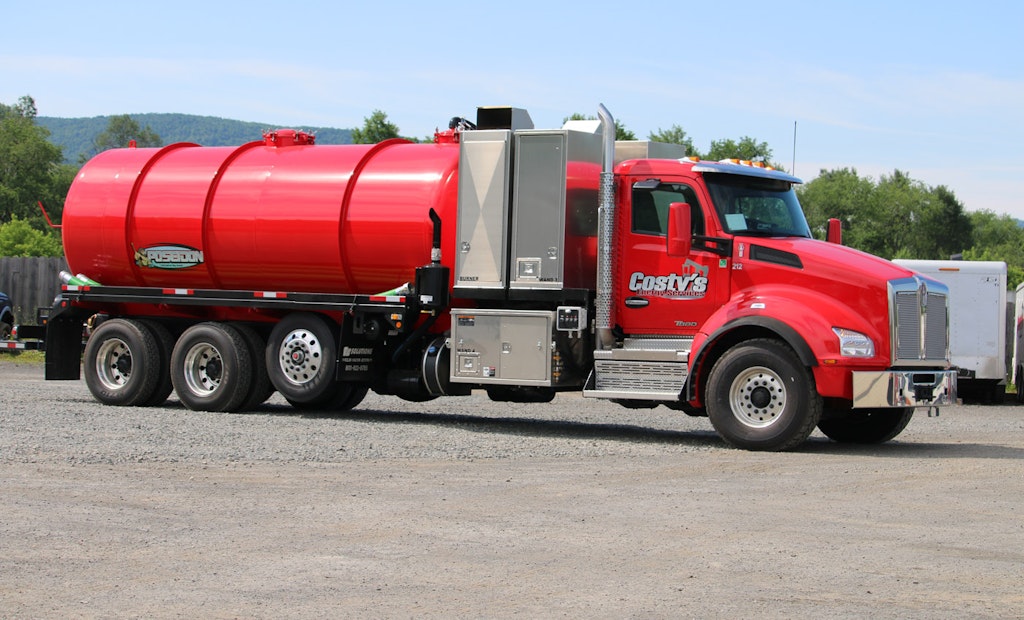
Costy’s Energy Services’ customized liquid vacuum truck from F.S. Solutions features four pressure-washing guns and a 4,620-gallon debris tank that serves primarily as a water tank. The truck has cut the time required to clean oilfield drilling equipment by 30 to 40 percent.
When drilling rigs aren’t working, they’re not making money for production companies. As such, when a rig is finished drilling, it’s critical for contractors like Costy’s Energy Services to clean all the associated components — frac tanks, drilling structures and the like — quickly and efficiently, so they can be moved on to the next drilling site as fast as possible.
To hasten the cleaning process and improve customer satisfaction, Costy’s Energy Services — an oilfield-services company based in Mansfield, Pennsylvania — invested roughly $350,000 in a customized liquid vacuum truck manufactured by F.S. Solutions. The hybrid truck features four pressure-washing guns for maximum cleaning productivity and a 4,620-gallon debris tank that serves primarily as a water tank, says Matt Kurzejewski, chief operating officer and vice president of Costy’s Energy Services.
“We call it Poseidon, the god of rig wash,” he says, referring to a decal on the side of the truck’s tank. “We’ve found it’s a very fitting nickname.”
The bottom line: The truck decreases rig-cleaning time by an average of 30 to 40 percent, which translates into dramatically less downtime in between moves from one drilling pad to the next. “Downtime costs production companies about $4,200 an hour,” Kurzejewski says. “We did our last rig move in about one and a half days less than normal, so we saved that customer about $151,000. And when you can provide better service for customers and save them money, too, it helps ensure long-term business relationships.”
As a bonus, the truck is much easier to maneuver on congested drilling pads than the equipment the company used before. Drilling pads are notoriously congested — a thicket of vehicles, equipment and structures that compete for elbow room in a space that measures roughly 350 by 350 feet. And the drilling rig itself consumes almost half that space. But maneuvering in close quarters is much less of an issue now for Costy’s Energy Services, courtesy of the truck’s 38-foot length.
The one-of-a-kind unit is built on a Kenworth Truck Co. T880 tandem-axle chassis. The truck features a hydraulically driven, 350 cfm vane vacuum pump; two 800,000 Btu water heaters; and two hydraulically driven triplex water pump systems (20 gpm at 3,000 psi each) with infinite variable-flow control. (Each pump system supplies water for two pressure-washing guns; when used in tandem, the guns’ water flow maxes out at 10 gpm.)
Wanting more
Kurzejewski’s father, Dan, first approached F.S. Solutions officials approximately two years ago about developing a customized vehicle. At the time, the company’s rig-cleaning method required a dually pickup truck, a 26-foot-long trailer equipped with four separate pressure washers and a 30-foot-long water truck — an unwieldy combination on crowded drilling pads.
“He wanted to build something much more bad-ass than what we had … something no one else would have,” Kurzejewski says. “He wanted more volume of water per minute and more pressure to cut cleaning time and significantly improve rig-moving time.”
A key feature on the truck are the pressure washers, which Kurzejewski says are very reliable because they’re hydraulically powered. “If the pumps aren’t hydraulically driven, they tend to need a lot of maintenance and repairs on a consistent basis,” he says.
The pressure washers are used on everything from derrick components to frac tanks, which are particularly difficult to clean. How dirty can a frac tank get? Kurzejewski says that to get an idea, imagine opening a 30-year-old oil can. “Empty it out, jump into it and roll around inside the can,” he says. “That’s how dirty it can get. The drilling fluids thicken and solidify, and everything on the pad has to be cleaned before it can be moved.”
Immediate impact
Costy’s Energy Services took delivery of the truck in early June. After the first job, Kurzejewski came away impressed with its performance. “It definitely gave us increased efficiency and productivity,” he says. “And the customer was even more impressed than we were because they’d never seen anything like it before.”
To run all four pressure washers at the same time still requires four employees, plus a supervisor to monitor the truck. The company’s old cleaning configuration also required four employees and a supervisor, so there’s no savings in terms of labor and operational costs, Kurzejewski points out. But in terms of improving customer service, there’s no question the unit is making an impact, he says. In addition, since the tank can also be used to vacuum up liquid waste, there’s potential for eventually breaking into new business markets.
“The truck cost about three times as much as the equipment we used to have (to do the same jobs),” he points out. “But it has created an uptick in our business — the word gets around in the oilfields. Overall, it’s increasing our performance and enhancing our business relationships. So it’s been a very worthwhile investment in the long term.”





